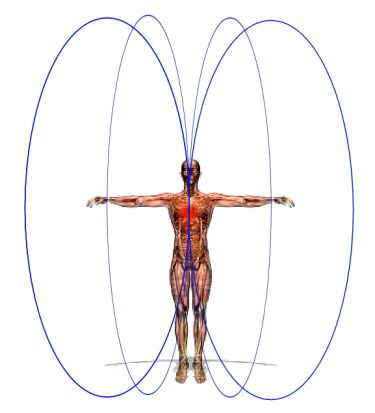Quantum Physics & Meditation
In recent years, quantum physicists have been starting to
explore how meditation may change the structure of the mind
and how mediators may be capable of actually re-wiring the synapses
(electrochemical pathways transmitting neurons / nerve cells)
in their own brains. This research, as typically
characteristic of most work in quantum physics, appears to
contradict concepts of classic Newtonian mechanics. In
Non-Newtonian (quantum) physics, our rudimentary understanding
of matter and particles begins to break down when we look to
the sub-atomic level.

Figure taken from torusgallery.com
For most engineering purposes, for example, Newtonian physics is exactly what is needed for structural and mechanical design. Newtonian physics is also highly applicable when we look at the macro-level structure of the human body in asana (physical poses), though, as explained earlier, asana traditionally is a much smaller part of yoga that is a pathway to accessing other stages of the Astanga yoga system. However, when approaching the topic of meditation, the concept of "self", and conscious control over the electromagnetic fields of the human body, we look to the sub-atomic science of quantum physics.
The concept of string theory, also known a the "theory of everything" is the idea that the point particles of matter may also be thought of as one-dimensional strings. According to string theory, strings can oscillate in many ways and each oscillation mode gives rise to a different species of particle, with mass, charge, and other properties determined by the string's dynamics (Wikipedia.org). Splitting and recombination of strings correspond to particle emission and absorption, giving rise to the interactions between particles (Wikipedia.org). There are theories that ancient eastern methods of meditation may be able to access control these vibrations, at least within our own physical bodies and brain structures.Neuropsychological research on the neural basis of behavior generally posits that brain mechanisms will ultimately suffice to explain all psychologically described phenomena. This assumption stems from the idea that the brain is made up entirely of material particles and fields, and that all causal mechanisms relevant to neuroscience can therefore be formulated solely in terms of properties of these elements. This theoretical restriction is motivated primarily by ideas about the natural world that have been known to be fundamentally incorrect for more than three-quarters of a century. Contemporary basic physical theory differs profoundly from classic physics on the important matter of how the consciousness of human agents enters into the structure of empirical phenomena. The new principles contradict the older idea that local mechanical processes alone can account for the structure of all observed empirical data. Indeed, owing to certain structural features of ion channels critical to synaptic function, contemporary physical theory must in principle be used when analyzing human brain dynamics. The new framework is able to represent more adequately than classic concepts the neuroplastic mechanisms relevant to the growing number of empirical studies of the capacity of directed attention and mental effort to systematically alter brain function.
(Schwartz et al. 2005)
Classically, a field is an area in which a force exerts an influence at every point. Like all energetic structures, a field involves a vibration of energy and can carry information. Fields operate on both physical and subtle planes, as do energy bodies and channels. Albert Einstein believed that the universe is composed of interconnected force fields; recent physicists have pinpointed some of these fields as spherical standing waves, viewing them as constructs of finite reality held within a greater infinity. Some physicists suggest that all possible events exist simultaneously as wave patterns that are either becoming real or disintegrating. A field can be deciphered, altered, molded, and analyzed outside of the body to alter the energies inside the body and vice versa.
Veritable or measurable energy fields are physical in nature and include sound and electromagnetic forces, such as visible light, magnetism, monochromatic radiation, and rays from the electromagnetic spectrum. Our body produces or is affected by all these energies. Putative energy fields are also called biofields or subtle fields. These fields explain the presence of vital life energy, such as the chi or prana of the Oriental and Hindu cultures. The human body is affected by and creates both types of energy fields.
Each of us (and the world) is made up of both measurable and subtle fields that create and sustain life. The primary differences between physical and subtle fields are often simply the speed of the information and vibrations involved. Within the division of material and subtle energy lies yet another subdivision: that of form versus thought. Certain fields are managed by pure form, others by thought and the physical heart.
(Dale 2009)